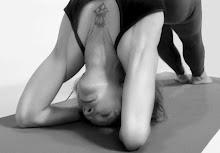Asana

As you may have noticed from the previous post, sometimes one must take a lighter view of practice in order to get through it. Asana, the physical practice of Yoga, can be a challenge if you want to make progress. Some of the challenges can involve pain, injury, frustration, starting over multiple times before finding the subtleties and nuances that allow for a fluid link between breath and movement as well as how to apply the Yamas and Niyamas to ones' own body and mind.
According to Sri K. Pattabhi Jois of Mysore India (the Guru of what is commonly referred to Ashtanga Yoga in the West), Yoga is "99% practice, only 1% theory", and "Do practice, all is coming". Traditionally, practice is done six days per week in the early morning with Saturdays and "moon days" off. Many Americans have a dim view of this, thinking that practice must be extremely intense every day; this only results in injuries and so many think that Ashtanga Yoga injures people or that its teachers injure people.
Remembering that the first Yama is Ahimsa, and that one must first learn to practice on ones' self, this system teaches the practitioner to take responsibility for his or her own practice and its progression. In the traditional system, students begin with the Sun Salutations (Surya Namaskar A & B) and do not go further until these are mastered. This ensures a base of strength and endurance is built up as well as the skill necessary to practice every day. The secret is to do a little bit at the beginning and gradually add to what is done. Giving the body time to rest and adjust keeps you from overtraining. As you rest, you can observe your body's reactions to the practice - where are your muscles sore? Do you feel overtired for the rest of the day? Are you eating enough to sustain your practice? (If not, you may develop migraines, be more susceptible to illness or injury, or suffer a "crash" midday).
Injuries can still be an opportunity for growth in your practice. Rodney Yee, the famous teacher from the Yoga Journal video/dvd series, says that pain is our teacher. We should not be so quick to move away from it as we can learn much about ourselves while we are learning to relax in each asana. Are we holding tension in the shoulders? Putting too much weight on the heel of the hand instead of distributing the pressure evenly through the fingers? Are we breathing properly?
Sometimes our Yoga practice is not the source of our pain but merely points the way to a greater awareness of the daily habits that cause our pain. Do you slouch at your desk all day, rarely getting up to stretch or walk around? Do you carry all of your bags on one shoulder all of the time? These daily habits set your body up for chronic pain or injury by allowing for muscular imbalances which can put pressure on spinal nerves.
Slowly, we build an awareness of our physical bodies and what is needed to bring the body into balance. As the body becomes balanced, the mind is less distracted by pain and suffering. As we become less distracted, we can then begin the process of learning to focus the mind.
Then, the real Yoga begins - the journey towards liberation that begins with Yama and continues through the eight limbs towards Samadhi, or Absorption in the Infinite Divine.


0 Comments:
Post a Comment
<< Home